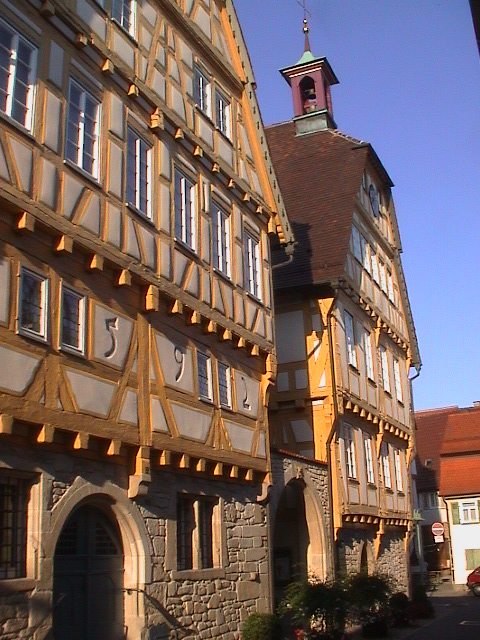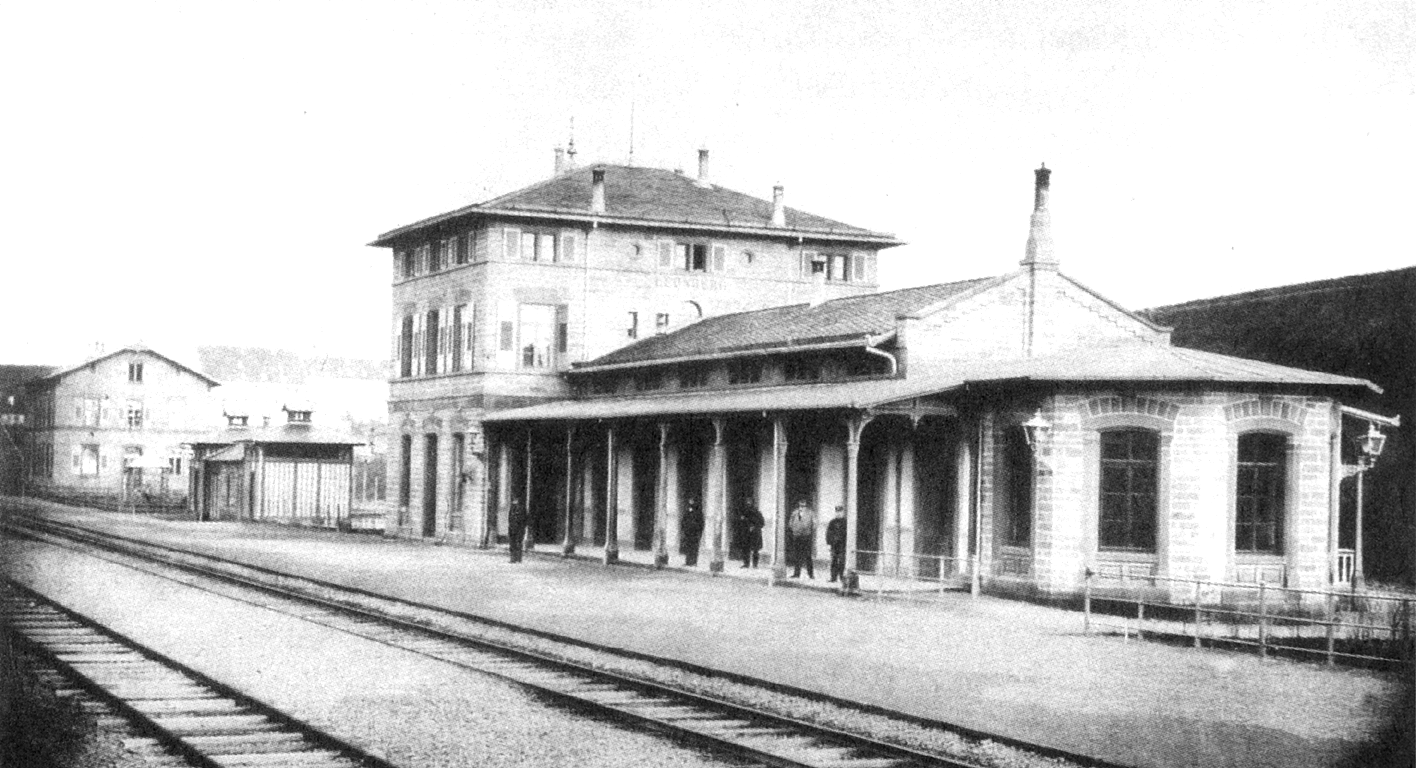|
Renningen Station
Renningen station serves the town of Renningen in the German state of Baden-Württemberg. It is at the junction of the Rankbach Railway (german: Rankbachbahn) and the Württemberg Black Forest Railway (''Schwarzwaldbahn''). It is a station on the Stuttgart S-Bahn network. History From 1865 onwards Renningen was expecting a rail connection to be built to it, but the Royal Württemberg State Railways was only able to build the Black Forest Railway in stages. The Ditzingen–Weil der Stadt section was opened on 1 December 1869. The station was about one kilometre north of the location of the village at that time. The present ''Bahnhofstraße'' was a dirt road that ran through marshes and fields to the new railway, which was widened just before the line opened. Carters however used the road to Rutesheim and left it, where it was closest to the station. There, the municipality built a straight paved road (now called ''Alte Bahnhofstraße'', “Old Station Street”) to connect with ... [...More Info...] [...Related Items...] OR: [Wikipedia] [Google] [Baidu] |
Renningen
Renningen is a town in the district of Böblingen, Baden-Württemberg, Germany. It is situated 18 km west of Stuttgart. Geography Renningen is located in the west of Stuttgart, between Leonberg and Weil der Stadt on the fringes of the fertile plains of the Neckarland. The Rankbach valley extends here to the Renningen Basin. Neighbouring municipalities Magstadt, Weil der Stadt, Leonberg, Rutesheim, Heimsheim History Renningen lies in an area which even in the Early Stone Age was thickly populated. Proof of this are the many remains found of settlements from the linear pottery culture. Remains of settlements found to originate with the Urnenfelderkultur (c. 1000 BC) as well the Hallstatt- and La Tène culture (Early to Late Iron Age), provide evidence of settlement during various prehistoric eras. The evaluation of archeological digs and finds show expansion of two early Alemannic settlements within the Renningen Basin north and south of the Rankbach. Excavations ... [...More Info...] [...Related Items...] OR: [Wikipedia] [Google] [Baidu] |
Luftwaffe
The ''Luftwaffe'' () was the aerial-warfare branch of the German ''Wehrmacht'' before and during World War II. Germany's military air arms during World War I, the ''Luftstreitkräfte'' of the Imperial Army and the '' Marine-Fliegerabteilung'' of the Imperial Navy, had been disbanded in May 1920 in accordance with the terms of the 1919 Treaty of Versailles which banned Germany from having any air force. During the interwar period, German pilots were trained secretly in violation of the treaty at Lipetsk Air Base in the Soviet Union. With the rise of the Nazi Party and the repudiation of the Versailles Treaty, the ''Luftwaffe''s existence was publicly acknowledged on 26 February 1935, just over two weeks before open defiance of the Versailles Treaty through German rearmament and conscription would be announced on 16 March. The Condor Legion, a ''Luftwaffe'' detachment sent to aid Nationalist forces in the Spanish Civil War, provided the force with a valuable testing grou ... [...More Info...] [...Related Items...] OR: [Wikipedia] [Google] [Baidu] |
Railway Stations In Baden-Württemberg
Rail transport (also known as train transport) is a means of transport that transfers passengers and goods on wheeled vehicles running on rails, which are incorporated in tracks. In contrast to road transport, where the vehicles run on a prepared flat surface, rail vehicles (rolling stock) are directionally guided by the tracks on which they run. Tracks usually consist of steel rails, installed on sleepers (ties) set in ballast, on which the rolling stock, usually fitted with metal wheels, moves. Other variations are also possible, such as "slab track", in which the rails are fastened to a concrete foundation resting on a prepared subsurface. Rolling stock in a rail transport system generally encounters lower frictional resistance than rubber-tyred road vehicles, so passenger and freight cars (carriages and wagons) can be coupled into longer trains. The operation is carried out by a railway company, providing transport between train stations or freight customer facilit ... [...More Info...] [...Related Items...] OR: [Wikipedia] [Google] [Baidu] |
Stuttgart S-Bahn Stations
Stuttgart (; Swabian: ; ) is the capital and largest city of the German state of Baden-Württemberg. It is located on the Neckar river in a fertile valley known as the ''Stuttgarter Kessel'' (Stuttgart Cauldron) and lies an hour from the Swabian Jura and the Black Forest. Stuttgart has a population of 635,911, making it the sixth largest city in Germany. 2.8 million people live in the city's administrative region and 5.3 million people in its metropolitan area, making it the fourth largest metropolitan area in Germany. The city and metropolitan area are consistently ranked among the top 20 European metropolitan areas by GDP; Mercer listed Stuttgart as 21st on its 2015 list of cities by quality of living; innovation agency 2thinknow ranked the city 24th globally out of 442 cities in its Innovation Cities Index; and the Globalization and World Cities Research Network ranked the city as a Beta-status global city in their 2020 survey. Stuttgart was one of the host cities for ... [...More Info...] [...Related Items...] OR: [Wikipedia] [Google] [Baidu] |
Magstadt
Magstadt is a town in the German Federal state of Baden-Württemberg, in the district (Landkreis) Böblingen. It is located between Renningen and Sindelfingen Sindelfingen (Swabian: ''Sendlfenga'') is a city in Baden-Württemberg in south Germany. It lies near Stuttgart at the headwaters of the Schwippe (a tributary of the river Würm), and is home to a Mercedes-Benz assembly plant. History * 1155 � .... References Böblingen (district) Württemberg {{Böblingen-geo-stub ... [...More Info...] [...Related Items...] OR: [Wikipedia] [Google] [Baidu] |
Sindelfingen
Sindelfingen ( Swabian: ''Sendlfenga'') is a city in Baden-Württemberg in south Germany. It lies near Stuttgart at the headwaters of the Schwippe (a tributary of the river Würm), and is home to a Mercedes-Benz assembly plant. History * 1155 – First documented mention of Sindelfingen * 1263 – Sindelfingen was founded by Count Rudolf Scherer of Tübingen-Herrenberg * 1351 – The city was sold to Württemberg * Middle Ages – Notable weaving industry * 1535 – Entrance of the Protestant Reformation * 1944 – Stuttgart/Sindelfingen oil refinery bombed by the Oil Campaign of World War II * 1962 – Sindelfingen became a "Große Kreisstadt" (city with special governmental responsibilities within the larger county) * 1971 – Municipal annexation of the neighbouring villages Maichingen and Darmsheim * 1987 – The final traditional Sindelfinger Volksfest was held (the site was later required for a state-level horticulture and landscaping exhibition) The weaving industry surv ... [...More Info...] [...Related Items...] OR: [Wikipedia] [Google] [Baidu] |
Stuttgart-Zuffenhausen Station
Zuffenhausen station is a railway station of the Stuttgart S-Bahn in Zuffenhausen in the city of Stuttgart, in the German state of Baden-Württemberg. With its six platform tracks, it is one of the largest stations in Stuttgart. History Zuffenhausen station was opened by the Royal Württemberg State Railways on 15 October 1846. It was built as part of the Central Railway (''Centralbahn'') between Stuttgart and Ludwigsburg and had a one-story station building. Apart from passengers from Zuffenhausen, it was used especially for travellers to the neighbouring village of Korntal. In 1852 the State Railways, built a second track on the Northern Railway between Stuttgart and Bietigheim. From the early 1860s, the State Railways planned a line from Stuttgart to the Northern Black Forest. After long controversy over a route via Böblingen or via Zuffenhausen, the Württemberg parliament (''Landtag'') approved on 13 August 1865 a route for the Black Forest Railway that branched off the ... [...More Info...] [...Related Items...] OR: [Wikipedia] [Google] [Baidu] |
Leonberg Station
Leonberg station is a station located on the Black Forest Railway in the town of Leonberg in the German state of Baden-Württemberg. It is served by lines S 6 and S 60 of the S-Bahn. It is classified by Deutsche Bahn as a category 4 station. History A horse bus service had operated between Leonberg and Stuttgart from 1840. However, it could only carry twelve people and operated only two or three times a week. In 1863, representatives of the Oberamts (the districts of the time) of Calw and Nagold requested that their districts be connected to the railway network. Christian Maier, chief official of the Oberamt of Leonberg, agreed and suggested a route through Leonberg and Weil der Stadt. But the Oberamt of Böblingen wanted the benefits of a new railway and the member for Böblingen, Otto Elben, presented the parliament of Württemberg with his plan for a line from Böblingen. The heads of the Oberamts of the Black Forest distanced themselves from this discussion. Whether the ... [...More Info...] [...Related Items...] OR: [Wikipedia] [Google] [Baidu] |
Weil Der Stadt Station
Weil der Stadt station is a station located at the terminus of the Black Forest Railway in the town of Weil der Stadt in the German state of Baden-Württemberg. The section to Calw is disused. The station is the terminus of line S 6 of the S-Bahn. It is classified by Deutsche Bahn as a category 4 station. History In September 1862, the Royal Württemberg State Railways (german: Königlich Württembergischen Staats-Eisenbahnen) planned to build a railway from Illingen via Vaihingen an der Enz and Weil der Stadt to Calw. It did not pursue this project for long because the Kingdom of Württemberg had begun negotiations with the Grand Duchy of Baden in order to build the Nagold Valley Railway from Pforzheim. In February 1865, the Baden Government agreed to the construction of this line. On 13 August 1865, the parliament of Württemberg decided to build the Black Forest Railway from Zuffenhausen via Leonberg to Calw. This line connected Weil der Stadt to the rail network. The ... [...More Info...] [...Related Items...] OR: [Wikipedia] [Google] [Baidu] |
German Railway Station Categories
The approximately 5,400 railway stations in Germany that are owned and operated by the Deutsche Bahn subsidiary DB Station&Service are divided into seven categories, denoting the service level available at the station. This categorisation influences the amount of money railway companies need to pay to DB Station&Service for using the facilities at the stations. Categories Category 1 The 21 stations in Category 1 are considered traffic hubs. They are permanently staffed and carry all sorts of railway-related facilities, as well as usually featuring a shopping mall in the station. Most of these stations are the central (commonly referred to as main) stations (''Hauptbahnhof'' or ''Hbf'') of large cities with 500,000 inhabitants and above, though some in smaller cities, such as Karlsruhe Hauptbahnhof, are regarded as important because they are at the junction of important railway lines. Berlin, Hamburg, Munich and Cologne, the four biggest cities in Germany, have more than ... [...More Info...] [...Related Items...] OR: [Wikipedia] [Google] [Baidu] |
Deutsche Bahn
The (; abbreviated as DB or DB AG) is the national railway company of Germany. Headquartered in the Bahntower in Berlin, it is a joint-stock company ( AG). The Federal Republic of Germany is its single shareholder. describes itself as the second-largest transport company in the world, after the German postal and logistics company / DHL, and is the largest railway operator and infrastructure owner in Europe. Deutsche Bahn was the largest railway company in the world by revenue in 2015; in 2019, DB Passenger transport companies carried around 4.8 billion passengers, and DB logistics companies transported approximately 232 million tons of goods in rail freight transport. The group is divided into several companies, including ''DB Fernverkehr'' (long-distance passenger), '' DB Regio'' (local passenger services) and ''DB Cargo'' (rail freight). The Group subsidiary ''DB Netz'' also operates large parts of the German railway infrastructure, making it the largest rail network in ... [...More Info...] [...Related Items...] OR: [Wikipedia] [Google] [Baidu] |





